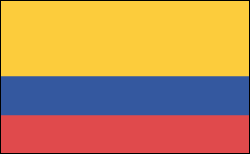Colombia History


Crossroads of the Americas
Humans have lived in Colombia for at least 11,000 years, and Colombia was a major channel for human migration to the rest of the continent. Although they are less widely known than, say, the Inca or the Nazca, we know a fair deal about the indigenous peoples of Colombia. With its connection to the isthmus of Panama, Colombia was a major center of migration between Central and South America. The different groups who settled what is now called Colombia include the Tairona, the Quimbaya, and the Muisca. By the time of the Spanish arrival in the 1500s, the Muisca were especially prominent in the area, having organized into a loose confederation that controlled a great deal of valuable land.
The different cultures that occupied Colombia shared much in common in terms of diet and material culture. Different amerindian groups from the area produced exceptional gold and ceramics, and they traded extensively. Then as now, Colombia was a major producer of coal and emerald (and still today is the world's leading exporter of emeralds). Most Colombian societies were agricultural, and practiced many different forms of social organization.
The Colonial Era
The Spanish, having begun their colonization of the Caribbean, expanded their empire onto the continental mainland at the start of the 1500s. In 1508, Vasco Nuñez de Balboa reached Colombia alongside Martín Fernández de Enciso. Two years later they would found Darien, the first permanent European settlement on the American mainland. In 1538 they established the colony of New Granada, the area's name until 1861.
As with most other Spanish conquests in the Americas, the Spanish conquistadors exploited local rivalries and tensions to their advantage; in the case of the New Granada colony, they forged alliances with competitors to the Muisca Confederation. After conquering the Muisca and settling Bogotá, Spain was largely uncontested in the region. These groups also experienced large-scale depopulation due to disease, as happened elsewhere.
Local amerindian populations formed an important part of the labor force and the economy, so their depopulation posed serious long-term problems to colonial authorities. This prompted the government to sell off large tracts of land to interested developers, which encouraged immigration.
Bolívar and Independence
After a 14-year struggle, during which time Simón Bolívar's Venezuelan troops won the battle of Boyacá in Colombia on Aug. 7, 1819, independence was attained in 1824. Bolívar united Colombia, Venezuela, Panama, and Ecuador in the Republic of Greater Colombia (1819–1830), but he lost Venezuela and Ecuador to separatists. Two political parties dominated the region: the Conservatives believed in a strong central government and a powerful church; the Liberals believed in a decentralized government, strong regional power, and a less influential role for the church. Bolívar was himself a Conservative, while his vice president, Francisco de Paula Santander, was the founder of the Liberal Party.
Santander served as president between 1832 and 1836, a period of relative stability, but by 1840 civil war had erupted. Other periods of Liberal dominance (1849–1857 and 1861–1880), which sought to disestablish the Roman Catholic Church, were marked by insurrection. Nine different governments followed, each rewriting the constitution. In 1861, the country was called the United States of New Granada; in 1863 it became the United States of Colombia; and in 1885, it was named the Republic of Colombia.
In 1899, a brutal civil war broke out, the War of a Thousand Days, that lasted until 1902. The following year, Colombia lost its claims to Panama because it refused to ratify the lease to the United States of the Canal Zone. Panama declared its independence in 1903.
La Violencia
The Conservatives held power until 1930, when revolutionary pressure put the Liberals back in power. The Liberal administrations of Enrique Olaya Herrera and Alfonso López (1930–1938) were marked by social reforms that failed to solve the country's problems, and in 1946, a period of insurrection and banditry broke out, referred to as La Violencia, which claimed hundreds of thousands of lives by 1958. Laureano Gómez (1950–1953); the army chief of staff, Gen. Gustavo Rojas Pinilla (1953–1956); and a military junta (1956–1957) sought to curb disorder by repression.
The Colombian Conflict
Marxist guerrilla groups organized in the 1960s and 1970s, most notably the May 19th Movement (M-19), the National Liberation Army (ELN), and the Revolutionary Armed Forces of Colombia (FARC), plunged the country into violence and instability. In the 1970s and 1980s, Colombia became one of the international centers for illegal drug production and trafficking, and at times the drug cartels (the Medellin and Cali cartels were the most notorious) virtually controlled the country. Colombia provides 75% of the world's illegal cocaine. In the 1990s, numerous right-wing paramilitary groups also formed, made up of drug traffickers and landowners. The umbrella group for these paramilitaries is the United Self-Defense Forces of Colombia (AUC).
Belisario Betancur Cuartas, a Conservative who assumed the presidency in 1982, unsuccessfully attempted to stem the guerrilla violence. In an official war against drug trafficking, Colombia became a public battleground with bombs, killings, and kidnappings. By 1989, homicide had become the leading cause of death in the nation. Elected president in 1990, César Gaviria Trujillo proposed lenient punishment in exchange for surrender by the leading drug dealers. Ernesto Samper of the Liberal Party became president in 1994. In 1996 he was accused of accepting campaign contributions from drug traffickers, but the House of Representatives absolved him of the charges.
Andrés Pastrana Arango was elected president in 1998, pledging to clean up corruption. In Dec. 1999, the Colombian military announced that 2,787 people were kidnapped that year—the largest number in the world—and blamed rebels. The murder rate soared in 1999, with some 23,000 people reported killed by leftist guerrillas, right-wing paramilitaries, drug traffickers, and common criminals. The violence has created more than 100,000 refugees, while 2 million Colombians have fled the country in recent years.







